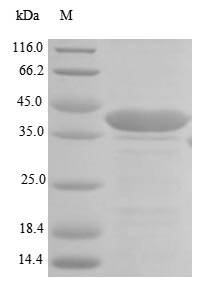Recombinant Human Laminin subunit beta-1 (LAMB1) is produced in E. coli and comprises a partial sequence from amino acids 1533 to 1782, tagged with an N-terminal 6xHis-SUMO tag. The protein exhibits a purity level greater than 85% as determined by SDS-PAGE. This product is intended for research use only.
Laminin subunit beta-1 appears to be a crucial component of the extracellular matrix, playing what seems to be a significant role in cell adhesion, differentiation, and migration. It's part of the laminin family, which is involved in the assembly and stability of basement membranes. Studying LAMB1 may be essential for understanding tissue development and repair processes, making it a potentially valuable target in cellular biology research.
Potential Applications
Note: The applications listed below are based on what we know about this protein's biological functions, published research, and experience from experts in the field. However, we haven't fully tested all of these applications ourselves yet. We'd recommend running some preliminary tests first to make sure they work for your specific research goals.
Based on the provided information, the recombinant Human LAMB1 fragment is expressed in E. coli, a prokaryotic system that is generally unsuitable for producing properly folded eukaryotic extracellular matrix proteins like LAMB1. Laminins require precise folding, disulfide bond formation, and glycosylation for their structural and functional integrity, none of which E. coli can provide adequately. The protein is a partial fragment (1533-1782aa) representing only a small portion of the full-length protein, and contains an N-terminal 6xHis-SUMO tag that may further interfere with proper folding. Since activity is unverified and the expression system is mismatched for this complex eukaryotic protein, the protein is highly likely to be misfolded and inactive without experimental validation.
1. Antibody Development and Validation
This application is appropriate. The recombinant LAMB1 fragment can serve as an effective immunogen for generating antibodies that recognize linear epitopes within the 1533-1782aa region. The tags facilitate purification and screening. However, if the protein is misfolded (as is likely in E. coli), antibodies may not recognize conformational epitopes of native LAMB1 in physiological contexts. It should be noted that validation against full-length, properly folded LAMB1 is essential for physiological relevance.
2. Protein-Protein Interaction Studies
This application is high-risk without folding validation. While the tags enable technical feasibility for pull-down assays, if the LAMB1 fragment is misfolded, it may not interact physiologically with true binding partners. The SUMO tag may improve solubility, but cannot compensate for the lack of proper eukaryotic folding. Identified interactions may be artifactual. This application should not be pursued without prior confirmation of proper folding.
3. Biochemical Characterization and Biophysical Analysis
This application is well-suited and should be prioritized. Techniques like circular dichroism spectroscopy, mass spectrometry, and thermal stability assays can directly assess the protein's folding state and properties. These studies are valuable even if the protein is misfolded, as they characterize the recombinant product itself. These assays are quality control measures rather than functional validation.
4. ELISA-Based Binding Assays
This application is problematic without folding validation. If the LAMB1 fragment is misfolded, binding sites for extracellular matrix components or receptors may be altered or absent, leading to inaccurate binding data. The oriented immobilization via His-tag is technically feasible but does not ensure physiological relevance. This application requires prior validation of proper folding and binding functionality.
Final Recommendation & Action Plan
Given the high probability of misfolding due to E. coli expression and the fragmentary nature of the protein, we recommend first performing a comprehensive biophysical characterization (circular dichroism for secondary structure, size-exclusion chromatography for aggregation state) to assess folding quality. Antibody development can proceed immediately, but resulting antibodies should be validated against native LAMB1 from mammalian sources. Avoid interaction and binding studies until proper folding is confirmed. For reliable LAMB1 functional studies, consider obtaining full-length protein from mammalian expression systems capable of proper folding and post-translational modifications. If misfolding is detected, focus applications on antibody development and biochemical characterization rather than functional assays.






